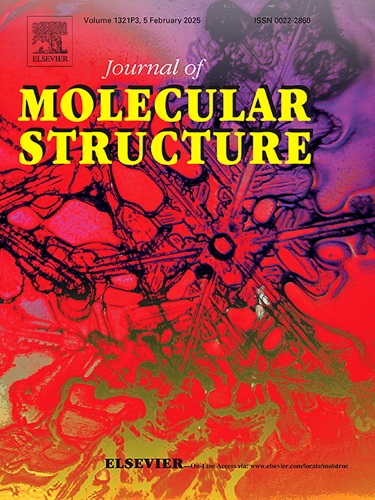Bifunctional Co(II)-porphyrin 1D-coordination polymer for selective cyanide sensing in tobacco smoke and efficient solid-liquid extraction
IF 4
2区 化学
Q2 CHEMISTRY, PHYSICAL
引用次数: 0
Abstract
Selective chromogenic sensing and extraction of cyanide (CN−) is a central issue of supramolecular chemistry and analytical sciences that impact biological and environmental chemistry. In this work, we reported a 1D coordination polymer [Co(TPyP)] (TPyP= dianion of 5,10,15,20-tetrapyridylporphyrin) that contains an open coordination site on Co(II) atom that acts as a high-affinity binding point for CN− recognition. This Co(II)-polymer was structurally described by X-ray diffraction and Hirschfeld surfaces. Also, it was thoroughly characterized by several spectroscopic tools and scanning electron microscopy (SEM) with energy-dispersive X-ray spectroscopy (EDS). [Co(TPyP)] was found to be an exceptionally high overall binding constant for CN− (log β= 10.04) with an equilibrium model 1:2 in CH3CN and highly selectivity over common interfering anions including halides and basic oxyanions. Under these conditions, CN− can be sense with a limit of detection of 5.40 μM by UV–Vis and visual change of the solution. On the basis of analytical tools (electrospray ionization mass spectrometry, X-ray single-crystal diffraction, infrared spectroscopy, UV–Vis) and time-dependent density functional theory (TD-DFT) calculations the spectrophotometric change is attributed to the coordination of two CN− ions in the axial positions of the Co(II) atom, with simultaneous formation of anionic complex [Co(TPyP)(CN)2]−2.
[Co(TPyP)] can operate efficiently as an optical selective sensor for CN− in commercial cigarettes in the micromolar concentration range. Additionally, this Co(II)-polymer can capture selectively CN− in solid-liquid extractions. The development of bifunctional molecules able to visually sense CN− ions and extract them from solid crystalline salts has not been explored until now.

求助全文
约1分钟内获得全文
求助全文
来源期刊

Journal of Molecular Structure
化学-物理化学
CiteScore
7.10
自引率
15.80%
发文量
2384
审稿时长
45 days
期刊介绍:
The Journal of Molecular Structure is dedicated to the publication of full-length articles and review papers, providing important new structural information on all types of chemical species including:
• Stable and unstable molecules in all types of environments (vapour, molecular beam, liquid, solution, liquid crystal, solid state, matrix-isolated, surface-absorbed etc.)
• Chemical intermediates
• Molecules in excited states
• Biological molecules
• Polymers.
The methods used may include any combination of spectroscopic and non-spectroscopic techniques, for example:
• Infrared spectroscopy (mid, far, near)
• Raman spectroscopy and non-linear Raman methods (CARS, etc.)
• Electronic absorption spectroscopy
• Optical rotatory dispersion and circular dichroism
• Fluorescence and phosphorescence techniques
• Electron spectroscopies (PES, XPS), EXAFS, etc.
• Microwave spectroscopy
• Electron diffraction
• NMR and ESR spectroscopies
• Mössbauer spectroscopy
• X-ray crystallography
• Charge Density Analyses
• Computational Studies (supplementing experimental methods)
We encourage publications combining theoretical and experimental approaches. The structural insights gained by the studies should be correlated with the properties, activity and/ or reactivity of the molecule under investigation and the relevance of this molecule and its implications should be discussed.
 求助内容:
求助内容: 应助结果提醒方式:
应助结果提醒方式:


